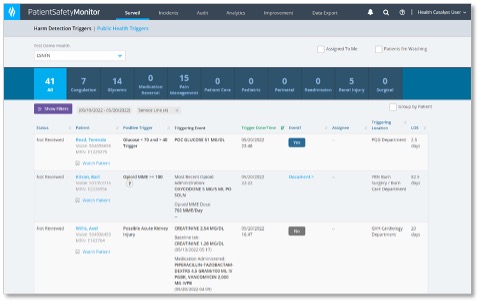For organizations that are striving to improve patient safety, incident reports are a valuable tool for safety leaders to identify and investigate conditions that may lead to errors or cause harm. Historically, incident reporting has involved complicated forms and a lack of transparency which can discourage employees from reporting events. The newest module in Health Catalyst’s Patient Safety Monitor application, Voluntary Event Reporting, provides an easy-to-use application that is convenient, efficient, productive, and informative. Voluntary Event Reporting offers game-changing support for organizations dedicated to nurturing a safety culture and leveraging reliable data and analytics for better outcomes by ensuring your teams have what they need to report events, follow up, learn, and improve.
 Download
Download

The erosion of patient safety gains amidst the COVID-19 pandemic continues to sound healthcare alarms. Leaders from the Centers for Medicare & Medicaid Services and the Centers for Disease Control and Prevention recently noted “We have observed substantial deterioration on multiple patient safety metrics since the beginning of the pandemic, despite decades of attention to complications of care,”
Safety audits and error reporting have also fallen by the wayside due in large part to the exhaustion of frontline staff and personnel shortages.
To improve safety, healthcare leaders must find new and simpler ways to support safety practices. They must renew their focus on creating a safety culture where staff continually scan and monitor their environment to identify and correct even minor deviations that could lead to unsafe conditions.
A holistic, data-driven approach to safety improvements — focused on incident reporting, automated event detection, and care audits — is imperative to future-proof healthcare organizations.
Simplify and safeguard incident reporting. The Institute for Healthcare Improvement (IHI) notes that error reporting should be one component of an organization’s larger effort to detect and prevent harm. IHI notes, “Public health researchers have established that only 10 to 20 percent of errors are ever reported and, of those, some 90 to 95 percent cause no harm to patients. For example, a wrong medication prepared and delivered to the patient may or may not cause harm.” Indeed, incident reporting is one piece of a broader safety strategy that identifies errors and helps pinpoint system flaws and failures that create opportunity for harm to occur.
IHI further elaborates on the value of focusing on harm with this example: “When a patient admitted for routine surgery gets a staph infection while an inpatient, that hospital-induced illness is certainly harmful. The harm is caused not by individual error but by an institution’s inadequate germ-protection system”.
Incident reporting is one of three important ways that actual or potential harm is identified; the other two methods include:
The unification of these three sources of safety event data within Patient Safety Monitor supports a comprehensive analysis of all-cause harm, within a single workflow tool. Organizations conduct deeper data analysis and improve their data interpretation accuracy to set priorities for improvement work and intervene to prevent or mitigate harm.
Incident reports are a valuable component of an enterprise safety program because they create visibility to conditions that lead to errors and may cause harm. Mistakes in healthcare are rarely due to a single point of failure; they almost always result from a combination of human error, unsafe procedures, and equipment.
Historic tendencies to blame individuals involved in safety events have led to a crisis of underreporting, where staff are unlikely to document mistakes or near misses for fear that they will be punished. And yet this lack of visibility prevents organizations from putting systems in place that would help guard against similar errors in the future.
Voluntary incident reporting allows safety leaders to identify and investigate conditions that create risk for error. An analysis of the root cause of each incident or event supports thorough consideration of all factors that may have led to the breach, including:
Incident reports help organizations evolve individual and system-level factors that contribute to medical error, foster transparency, and support a continuous improvement culture.
The newest module in Health Catalyst’s Patient Safety Monitor application, Voluntary Event Reporting, provides a streamlined and user-friendly workflow for healthcare staff to report safety events. Benefits include:
Event investigators use the same Voluntary Event Reporting module to document a detailed account of the chain of events leading up to and following each event. Structured forms support the collection of discrete data elements across a variety of incident types. The built-in feedback loop allows investigators to gather additional data from the reporter in a timely fashion.
Unlike legacy tools that discourage incident reporting with old technology, complicated forms, and the inability to inform the reporter of issue resolution, Health Catalyst’s Patient Safety Monitor leverages a modern user experience and comprehensive safety application to capture, investigate, analyze, and manage incidents. Effective and efficient incident reporting complements a broader safety strategy that provides visibility into all potential and actual harm occurring in an organization using a three-pronged approach: trigger-based data surveillance, incident reporting, and care audits.
Voluntary Event Reporting offers game-changing support for organizations dedicated to nurturing a safety culture and leveraging reliable data and analytics for better outcomes by ensuring your teams have what they need to report events, follow up, learn, and improve.
Would you like to learn more about this topic? Here are some articles we suggest:
Would you like to use or share these concepts? Download this presentation highlighting the key main points.
https://www.slideshare.net/healthcatalyst1/patient-safety-incident-reporting-functionality-reduces-barriers-and-improves-care